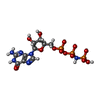+ Open data
Open data
- Basic information
Basic information
| Entry | Database: PDB / ID: 6e6h | ||||||
|---|---|---|---|---|---|---|---|
| Title | NRAS G13D bound to GppNHp (N13GNP) | ||||||
 Components Components | GTPase NRas | ||||||
 Keywords Keywords |  SIGNALING PROTEIN / SIGNALING PROTEIN /  Oncogene / RAS / p21 Oncogene / RAS / p21 | ||||||
| Function / homology |  Function and homology information Function and homology informationmyoblast differentiation / Signaling by RAS GAP mutants / Signaling by RAS GTPase mutants / Activation of RAS in B cells / tertiary granule membrane / RAS signaling downstream of NF1 loss-of-function variants / SOS-mediated signalling / Activated NTRK3 signals through RAS / Activated NTRK2 signals through RAS / SHC1 events in ERBB4 signaling ...myoblast differentiation / Signaling by RAS GAP mutants / Signaling by RAS GTPase mutants / Activation of RAS in B cells / tertiary granule membrane / RAS signaling downstream of NF1 loss-of-function variants / SOS-mediated signalling / Activated NTRK3 signals through RAS / Activated NTRK2 signals through RAS / SHC1 events in ERBB4 signaling / Signalling to RAS / SHC-related events triggered by IGF1R / Activated NTRK2 signals through FRS2 and FRS3 / Estrogen-stimulated signaling through PRKCZ / SHC-mediated cascade:FGFR3 / MET activates RAS signaling / PTK6 Regulates RHO GTPases, RAS GTPase and MAP kinases / Signaling by PDGFRA transmembrane, juxtamembrane and kinase domain mutants / Signaling by PDGFRA extracellular domain mutants / SHC-mediated cascade:FGFR2 / SHC-mediated cascade:FGFR4 / Signaling by FGFR4 in disease / SHC-mediated cascade:FGFR1 / Erythropoietin activates RAS / FRS-mediated FGFR3 signaling / Signaling by FLT3 ITD and TKD mutants / FRS-mediated FGFR2 signaling / FRS-mediated FGFR4 signaling / Signaling by FGFR3 in disease / FRS-mediated FGFR1 signaling / p38MAPK events / Tie2 Signaling / positive regulation of endothelial cell proliferation / Signaling by FGFR2 in disease / GRB2 events in EGFR signaling / SHC1 events in EGFR signaling / EGFR Transactivation by Gastrin / Signaling by FLT3 fusion proteins / FLT3 Signaling / Signaling by FGFR1 in disease / Ras activation upon Ca2+ influx through NMDA receptor / GRB2 events in ERBB2 signaling / NCAM signaling for neurite out-growth / CD209 (DC-SIGN) signaling / SHC1 events in ERBB2 signaling / Downstream signal transduction / Constitutive Signaling by Overexpressed ERBB2 / Insulin receptor signalling cascade /  small monomeric GTPase / G protein activity / Signaling by phosphorylated juxtamembrane, extracellular and kinase domain KIT mutants / VEGFR2 mediated cell proliferation / FCERI mediated MAPK activation / Signaling by ERBB2 TMD/JMD mutants / RAF activation / Signaling by high-kinase activity BRAF mutants / Constitutive Signaling by EGFRvIII / MAP2K and MAPK activation / Signaling by ERBB2 ECD mutants / Signaling by ERBB2 KD Mutants / Signaling by SCF-KIT / Regulation of RAS by GAPs / Negative regulation of MAPK pathway / RAS processing / Signaling by RAF1 mutants / GDP binding / Signaling by moderate kinase activity BRAF mutants / Paradoxical activation of RAF signaling by kinase inactive BRAF / Signaling downstream of RAS mutants / small monomeric GTPase / G protein activity / Signaling by phosphorylated juxtamembrane, extracellular and kinase domain KIT mutants / VEGFR2 mediated cell proliferation / FCERI mediated MAPK activation / Signaling by ERBB2 TMD/JMD mutants / RAF activation / Signaling by high-kinase activity BRAF mutants / Constitutive Signaling by EGFRvIII / MAP2K and MAPK activation / Signaling by ERBB2 ECD mutants / Signaling by ERBB2 KD Mutants / Signaling by SCF-KIT / Regulation of RAS by GAPs / Negative regulation of MAPK pathway / RAS processing / Signaling by RAF1 mutants / GDP binding / Signaling by moderate kinase activity BRAF mutants / Paradoxical activation of RAF signaling by kinase inactive BRAF / Signaling downstream of RAS mutants /  MAPK cascade / Signaling by BRAF and RAF1 fusions / DAP12 signaling / Constitutive Signaling by Ligand-Responsive EGFR Cancer Variants / RAF/MAP kinase cascade / Ras protein signal transduction / MAPK cascade / Signaling by BRAF and RAF1 fusions / DAP12 signaling / Constitutive Signaling by Ligand-Responsive EGFR Cancer Variants / RAF/MAP kinase cascade / Ras protein signal transduction /  Golgi membrane / Golgi membrane /  GTPase activity / Neutrophil degranulation / protein-containing complex binding / endoplasmic reticulum membrane / GTP binding / GTPase activity / Neutrophil degranulation / protein-containing complex binding / endoplasmic reticulum membrane / GTP binding /  Golgi apparatus / extracellular exosome / Golgi apparatus / extracellular exosome /  membrane / membrane /  plasma membrane / plasma membrane /  cytosol cytosolSimilarity search - Function | ||||||
| Biological species |   Homo sapiens (human) Homo sapiens (human) | ||||||
| Method |  X-RAY DIFFRACTION / X-RAY DIFFRACTION /  MOLECULAR REPLACEMENT / Resolution: 1.99 Å MOLECULAR REPLACEMENT / Resolution: 1.99 Å | ||||||
 Authors Authors | Johnson, C.W. / Mattos, C. | ||||||
| Funding support |  United States, 1items United States, 1items
| ||||||
 Citation Citation |  Journal: Cell Rep / Year: 2019 Journal: Cell Rep / Year: 2019Title: Isoform-Specific Destabilization of the Active Site Reveals a Molecular Mechanism of Intrinsic Activation of KRas G13D. Authors: Johnson, C.W. / Lin, Y.J. / Reid, D. / Parker, J. / Pavlopoulos, S. / Dischinger, P. / Graveel, C. / Aguirre, A.J. / Steensma, M. / Haigis, K.M. / Mattos, C. | ||||||
| History |
|
- Structure visualization
Structure visualization
| Structure viewer | Molecule:  Molmil Molmil Jmol/JSmol Jmol/JSmol |
|---|
- Downloads & links
Downloads & links
- Download
Download
| PDBx/mmCIF format |  6e6h.cif.gz 6e6h.cif.gz | 49 KB | Display |  PDBx/mmCIF format PDBx/mmCIF format |
|---|---|---|---|---|
| PDB format |  pdb6e6h.ent.gz pdb6e6h.ent.gz | 32.1 KB | Display |  PDB format PDB format |
| PDBx/mmJSON format |  6e6h.json.gz 6e6h.json.gz | Tree view |  PDBx/mmJSON format PDBx/mmJSON format | |
| Others |  Other downloads Other downloads |
-Validation report
| Arichive directory |  https://data.pdbj.org/pub/pdb/validation_reports/e6/6e6h https://data.pdbj.org/pub/pdb/validation_reports/e6/6e6h ftp://data.pdbj.org/pub/pdb/validation_reports/e6/6e6h ftp://data.pdbj.org/pub/pdb/validation_reports/e6/6e6h | HTTPS FTP |
|---|
-Related structure data
- Links
Links
- Assembly
Assembly
| Deposited unit | 
| ||||||||
|---|---|---|---|---|---|---|---|---|---|
| 1 |
| ||||||||
| Unit cell |
|
- Components
Components
| #1: Protein | Mass: 18855.256 Da / Num. of mol.: 1 / Fragment: residues 1-166 / Mutation: G13D Source method: isolated from a genetically manipulated source Source: (gene. exp.)   Homo sapiens (human) / Gene: NRAS, HRAS1 / Plasmid: pET21 / Details (production host): Ampicillin resistant / Production host: Homo sapiens (human) / Gene: NRAS, HRAS1 / Plasmid: pET21 / Details (production host): Ampicillin resistant / Production host:   Escherichia coli (E. coli) / Strain (production host): BL21 / References: UniProt: P01111 Escherichia coli (E. coli) / Strain (production host): BL21 / References: UniProt: P01111 |
|---|---|
| #2: Chemical | ChemComp-MG / |
| #3: Chemical | ChemComp-GNP /  5'-Guanylyl imidodiphosphate 5'-Guanylyl imidodiphosphate |
| #4: Water | ChemComp-HOH /  Water Water |
-Experimental details
-Experiment
| Experiment | Method:  X-RAY DIFFRACTION / Number of used crystals: 1 X-RAY DIFFRACTION / Number of used crystals: 1 |
|---|
- Sample preparation
Sample preparation
| Crystal | Density Matthews: 1.95 Å3/Da / Density % sol: 36.87 % |
|---|---|
Crystal grow | Temperature: 291.15 K / Method: vapor diffusion, hanging drop / pH: 7.5 Details: 9% 2-propanol, 72 mM HEPES, 20% PEG 4000, 15% stabilization buffer (20 mM HEPES, 50 mM NaCl, 20 mM MgCl2, at pH 7.5), Crystals were grown in 1uL by 1uL drops of mother liquor to protein (12. ...Details: 9% 2-propanol, 72 mM HEPES, 20% PEG 4000, 15% stabilization buffer (20 mM HEPES, 50 mM NaCl, 20 mM MgCl2, at pH 7.5), Crystals were grown in 1uL by 1uL drops of mother liquor to protein (12.2 mg/mL) No cryoprotectant used for diffraction |
-Data collection
| Diffraction | Mean temperature: 173.15 K | |||||||||||||||||||||||||||||||||||||||||||||||||||||||||||||||||||||||||||||||||||||||||||||||||||||||||||||||||||||||||||||||||||||||||||||||||||||||||||||||||||||||||||||||||||||||||||||
|---|---|---|---|---|---|---|---|---|---|---|---|---|---|---|---|---|---|---|---|---|---|---|---|---|---|---|---|---|---|---|---|---|---|---|---|---|---|---|---|---|---|---|---|---|---|---|---|---|---|---|---|---|---|---|---|---|---|---|---|---|---|---|---|---|---|---|---|---|---|---|---|---|---|---|---|---|---|---|---|---|---|---|---|---|---|---|---|---|---|---|---|---|---|---|---|---|---|---|---|---|---|---|---|---|---|---|---|---|---|---|---|---|---|---|---|---|---|---|---|---|---|---|---|---|---|---|---|---|---|---|---|---|---|---|---|---|---|---|---|---|---|---|---|---|---|---|---|---|---|---|---|---|---|---|---|---|---|---|---|---|---|---|---|---|---|---|---|---|---|---|---|---|---|---|---|---|---|---|---|---|---|---|---|---|---|---|---|---|---|---|
| Diffraction source | Source:  ROTATING ANODE / Type: RIGAKU MICROMAX-007 HF / Wavelength: 1.54178 Å ROTATING ANODE / Type: RIGAKU MICROMAX-007 HF / Wavelength: 1.54178 Å | |||||||||||||||||||||||||||||||||||||||||||||||||||||||||||||||||||||||||||||||||||||||||||||||||||||||||||||||||||||||||||||||||||||||||||||||||||||||||||||||||||||||||||||||||||||||||||||
| Detector | Type: RIGAKU RAXIS IV++ / Detector: IMAGE PLATE / Date: Jul 8, 2014 | |||||||||||||||||||||||||||||||||||||||||||||||||||||||||||||||||||||||||||||||||||||||||||||||||||||||||||||||||||||||||||||||||||||||||||||||||||||||||||||||||||||||||||||||||||||||||||||
| Radiation | Protocol: SINGLE WAVELENGTH / Monochromatic (M) / Laue (L): M / Scattering type: x-ray | |||||||||||||||||||||||||||||||||||||||||||||||||||||||||||||||||||||||||||||||||||||||||||||||||||||||||||||||||||||||||||||||||||||||||||||||||||||||||||||||||||||||||||||||||||||||||||||
| Radiation wavelength | Wavelength : 1.54178 Å / Relative weight: 1 : 1.54178 Å / Relative weight: 1 | |||||||||||||||||||||||||||||||||||||||||||||||||||||||||||||||||||||||||||||||||||||||||||||||||||||||||||||||||||||||||||||||||||||||||||||||||||||||||||||||||||||||||||||||||||||||||||||
| Reflection | Resolution: 2→50 Å / Num. all: 42385 / Num. obs: 9752 / % possible obs: 97 % / Redundancy: 4.3 % / Rmerge(I) obs: 0.098 / Rpim(I) all: 0.051 / Rrim(I) all: 0.112 / Χ2: 1.204 / Net I/σ(I): 8 / Num. measured all: 42385 | |||||||||||||||||||||||||||||||||||||||||||||||||||||||||||||||||||||||||||||||||||||||||||||||||||||||||||||||||||||||||||||||||||||||||||||||||||||||||||||||||||||||||||||||||||||||||||||
| Reflection shell | Diffraction-ID: 1
|
- Processing
Processing
| Software |
| ||||||||||||||||||
|---|---|---|---|---|---|---|---|---|---|---|---|---|---|---|---|---|---|---|---|
| Refinement | Method to determine structure : :  MOLECULAR REPLACEMENT / Resolution: 1.99→32.5 Å / Cross valid method: FREE R-VALUE MOLECULAR REPLACEMENT / Resolution: 1.99→32.5 Å / Cross valid method: FREE R-VALUE
| ||||||||||||||||||
| Displacement parameters | Biso max: 66.98 Å2 / Biso mean: 26.5736 Å2 / Biso min: 10.92 Å2 | ||||||||||||||||||
| Refinement step | Cycle: LAST / Resolution: 1.99→32.5 Å
|
 Movie
Movie Controller
Controller



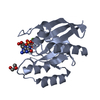




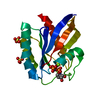
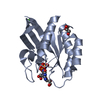


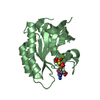

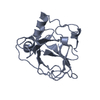

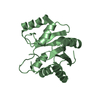
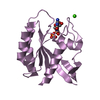
 PDBj
PDBj




















